November 7-14, 2002
"Tower Site" Does Dallas, part II
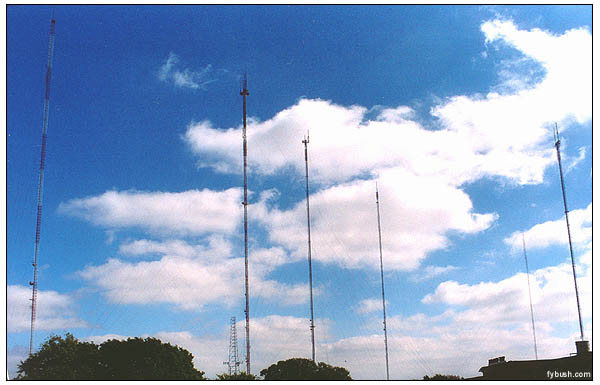
When we left you last week,
we were poking around the old WFAA-TV transmitter building at
Cedar Hill in the congenial company of transmitter engineer Don
Guemmer and our Dallas traveling companions, WFAA-TV audio production
whiz Wally Wawro, the National Radio Club's John Callarman and
the Boston Radio Archives' Garrett Wollman (who has a
whole bunch of pictures of his own, too...)
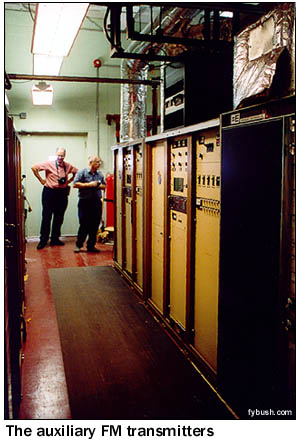 And
before we move on to the new WFAA-KDFW site just to the south
of the old tower, we should point out a few more goodies in the
old building. And
before we move on to the new WFAA-KDFW site just to the south
of the old tower, we should point out a few more goodies in the
old building.
After the Navy jet crashed into the old WFAA/KDFW/KXAS tower
here in 1989, forcing the top 500 feet of the 1500-foot tower
to be removed, the old tower remained in use, with new auxiliary
antennas for channels 4 and 8 installed up top and a whole batch
of auxiliary FM transmitters and antennas taking up residence
as well. What we're seeing in the picture at left is three auxiliary
transmitters for Infinity's FMs: KRBV (100.3), KOAI (107.5) and
KYNG (105.3), not necessarily in that order.
The old tower is also home to auxiliary transmitters for KKDA-FM
(104.5) and KDMX (102.9).
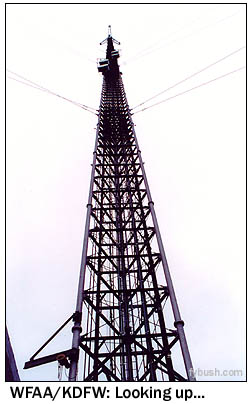 But
enough about the past; after that crash, the Hill Tower consortium
of WFAA and KDFW decided to build a new, taller candelabra to
the south of the old one. KXAS (Channel 5), the NBC affiliate
that had been a latecomer to the original candelabra (which was
the very first candelabra tower ever), decided to go its own
way, leasing land at the eastern edge of the Hill Tower property
for a new tower of its own. Former KXAS sister station KSCS (96.3,
the old WBAP-FM) moved there as well, and was joined later on
by the 97.9 that was WFAA-FM years ago, later to be known as
KZEW, KKWM, KLRX, KKRW and now KBFB. But
enough about the past; after that crash, the Hill Tower consortium
of WFAA and KDFW decided to build a new, taller candelabra to
the south of the old one. KXAS (Channel 5), the NBC affiliate
that had been a latecomer to the original candelabra (which was
the very first candelabra tower ever), decided to go its own
way, leasing land at the eastern edge of the Hill Tower property
for a new tower of its own. Former KXAS sister station KSCS (96.3,
the old WBAP-FM) moved there as well, and was joined later on
by the 97.9 that was WFAA-FM years ago, later to be known as
KZEW, KKWM, KLRX, KKRW and now KBFB.
Between the new channel 5 tower and the old Hill Tower tower,
three more tall towers lined up along Belt Line Road. You can
see them in the image at the top of the page; the leftmost tall
tower (and the most westerly) is today home to KNON (89.3), KVTT
(91.7), KPXD-DT (42) and the Clear Channel auxiliary transmitters;
next in line is a candelabra tower that hosts KZPS (92.5), KLNO
(94.1), KLTY (94.9), WRR (101.1), KKDA-FM (104.5), KHKS (106.1),
KDTN (2, a very late addition to the dial as a Denton-licensed
second PBS service owned by KERA-TV/FM that debuted only in the
late eighties), KTXA (21), KDFI (27), KDTX (58) and CPs for KUVN-DT
(24, a move-in from Garland, where Univision's analog KUVN operates
on channel 23), KDTX-DT (45) and KTAQ-DT (46, a move-in from
Greenville, where KTAQ-TV is on channel 47); the candelabra to
the right of that holds KEGL (97.1), KLUV (98.7), KVIL (103.7),
KFWD (52), KPXD (68) and CPs for KLTY (94.9), KKDA-FM (104.5)
and KFWD-DT (51); and after that comes channel 5's tower,
shared with KSCS (96.3) and KBFB (97.9).
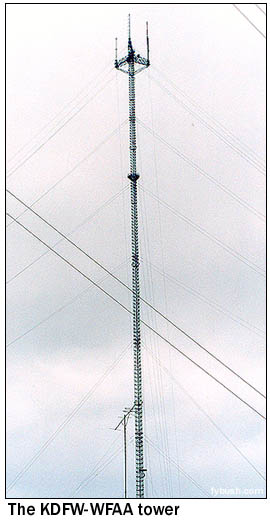 Off
in the distance towards the right edge of the frame is an FM
tower that's home to KRBV (100.3), KYNG (105.3) and KOAI (107.5)
with a CP for KRBV (100.3), and at the far edge of the frame,
looming over the old KDFW building, is the KXTX (39), KXTX-DT
(40) and KXAS-DT (41) tower, itself the victim of a collapse
in 1996, when a gust of wind apparently caught the gin pole being
used for tower work and blew it into several guy wires, killing
three employees of Doty-Moore Tower Services. (KRBV, KYNG and
KOAI were also on the KXTX tower then.) Off
in the distance towards the right edge of the frame is an FM
tower that's home to KRBV (100.3), KYNG (105.3) and KOAI (107.5)
with a CP for KRBV (100.3), and at the far edge of the frame,
looming over the old KDFW building, is the KXTX (39), KXTX-DT
(40) and KXAS-DT (41) tower, itself the victim of a collapse
in 1996, when a gust of wind apparently caught the gin pole being
used for tower work and blew it into several guy wires, killing
three employees of Doty-Moore Tower Services. (KRBV, KYNG and
KOAI were also on the KXTX tower then.)
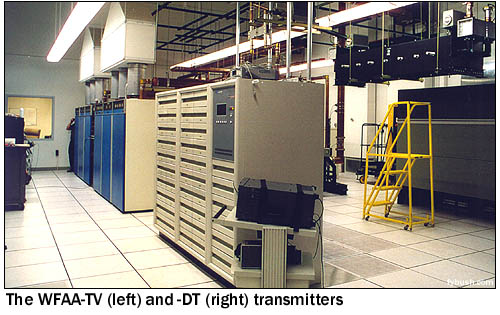
Back to KDFW and WFAA, though: they ended up at the western
edge of the Cedar Hill tower cluster, on the mightily tall tower
seen at left. On the candelabra up top, we find WFAA-TV at left
(east), KDFW in the center (north) and KDFW-DT (35) atop WFAA-DT
(9) at right (west).
The two stations share a mirror-image building at the base;
that's WFAA's space with the open garage doors at left, KDFW's
with the closed doors at right (and Wally walking past them while
Don made what proved to be a vain attempt to get us inside the
KDFW side...)
The space inside the building, at least on the WFAA side,
is simple and well laid-out: a long room for processing and transmitter
control racks, a smaller workroom off the side, and a very large
space designed to hold two TV transmitters. (The building dates
to the earliest days of designing for DTV, when it wasn't clear
just how large a DTV transmitter would be. As it turned out,
the space provided was far more than adequate, as you can see
above.)
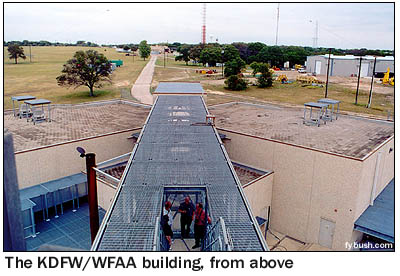 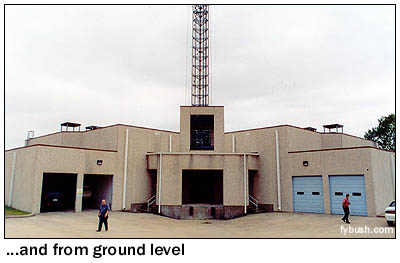
A few more interesting things about this site, while we're
here: yes, that's an ice bridge leading out to the tower from
the transmitter buildings. There really is ice, even in North
Texas, in enough quantity to make some impressive dents in the
roof, which is made up of concrete blocks over a foam substrate
that's supposed to absorb the force when the ice cracks the concrete
(which is then replaced in the spring.)
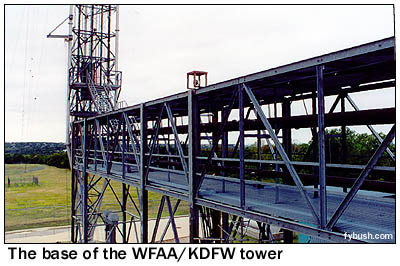 WFAA-DT
was one of the very first DTV stations on the air, so long ago
that it's already celebrating its fifth birthday, and when it
made its debut on channel 9 it wreaked some havoc in area hospitals,
which were using the channel 9 bandwidth (186-192 MHz) for medical
telemetry and had to retune when a new local signal popped up
unannounced. WFAA-DT
was one of the very first DTV stations on the air, so long ago
that it's already celebrating its fifth birthday, and when it
made its debut on channel 9 it wreaked some havoc in area hospitals,
which were using the channel 9 bandwidth (186-192 MHz) for medical
telemetry and had to retune when a new local signal popped up
unannounced.
While WFAA-DT has viewers as far south as Waco and north to
the Oklahoma line (and in several apartment complexes in the
Dallas area that use the DTV signals, downconverted to NTSC,
to feed their master antenna systems), it's been crunched of
late by KCEN-DT Temple, also on channel 9 and barely 100 miles
away. How did KCEN get assigned to channel 9 so close to WFAA?
We don't know - but it seems like another good reason to hope
for a timely transition to digital-only TV and eliminate some
of the signal crowding (WFAA-DT would likely end up back on channel
8 when that happens...)
A few more towers wrap up our visit to Cedar Hill: south of
the WFAA/KDFW tower is yet another tall stick that's home to
KPLX (99.5), KDGE (102.1), KDMX (102.9) and an auxiliary for
KVIL (103.7).
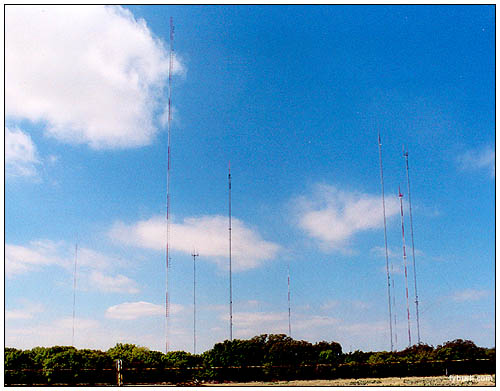
Heading to the next site on our agenda, we stop on the eastern
edge of the Hill Tower property to get a nice group shot of the
towers (yes, you can expect it to grace the 2004 Tower Site Calendar
in a year's time!)
Shown here, from left to right (south to north, roughly):
the KPLX/KDGE/KDMX tower, the KRBV/KYNG/KOAI tower (foreground),
WFAA/KDFW (rear), KXTX/KXAS-DT, the old Hill Tower Tower (rear),
KXAS/KSCS/KBFB, KNON/KVTT (barely visible far to rear and just
to the right of KXAS), KDTN/KTXA/KDFI/etc. (painted) and KFWD/KPXD/KEGL/KLUV/KVIL.
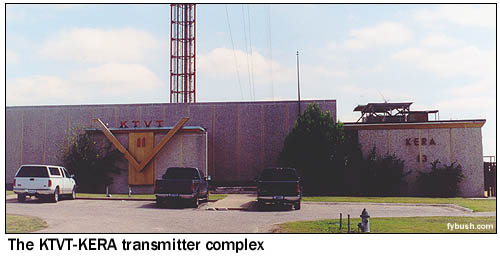 Away
from the Hill Tower property, a mile or so to the east on the
US 67 frontage road, a separate site is home to KTVT (Channel
11), the former independent (and long-ago KFJZ-TV) that became
a CBS affiliate (and eventually an O&O) when KDFW went to
Fox in 1995. Public broadcaster KERA-TV (13) and KERA-FM (90.1)
shares the stick - and you've got to love that groovy transmitter
building! Away
from the Hill Tower property, a mile or so to the east on the
US 67 frontage road, a separate site is home to KTVT (Channel
11), the former independent (and long-ago KFJZ-TV) that became
a CBS affiliate (and eventually an O&O) when KDFW went to
Fox in 1995. Public broadcaster KERA-TV (13) and KERA-FM (90.1)
shares the stick - and you've got to love that groovy transmitter
building!
We're not showing the top of this tower because it was in
something of a state of disarray; new antennas are going up here
for KERA-DT (14) and KTVT-DT (19), and everyone's using low-power
auxiliary antennas at the moment while the work goes on.
Still another cluster of towers sits about two miles to the
south off US 67; it's home to Telefutura's KSTR (49) and KSTR-DT
(48), religious KLDT (55) and KLDT-DT (54) and several LPTVs;
it will also eventually be home to KDTN-DT (43), which apparently
still won't fit on the rebuilt KTVT tower.
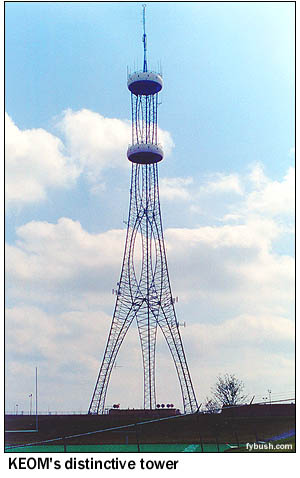 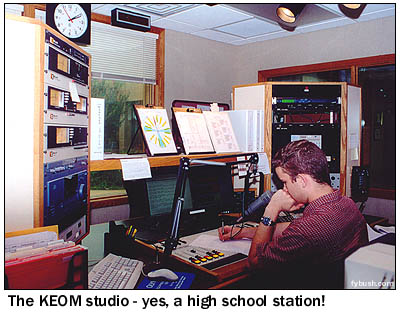
And with that, we say our farewells to Cedar Hill and head
back up north, where our next appointment is at a high school
radio station, KEOM (88.5) in Mesquite, just east of Dallas.
KEOM, licensed to the Mesquite Independent School District,
is most decidedly not your average high school station. If the
studio setup doesn't prove it, the format of 70s pop just might.
(It was chosen, by the way, to attract the parents of current
high school students. Feel old yet?)
And if none of that proves it to you, how about this: KEOM
operates with 61,000 watts of effective radiated power, blanketing
Dallas and vicinity from the antenna at the top of that very
funky tower behind one of Mesquite's several high school football
stadiums. It's a "Star Tower," made by the same folks
who gave Cincinnati its channel 64 tower and Washington its channel
50 tower, and it was paid for by wireless companies eager to
give the city of Mesquite and the Mesquite schools transmitter
space in exchange for the land to build this stick for their
own uses.
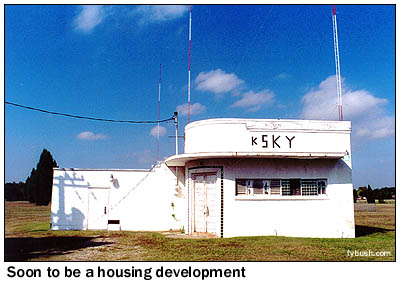 By the time we're
done with KEOM, it's well past three, and we're still going,
notching a few more AM sites on Dallas' east side, including
the single stick of KGGR (1040), an unexciting tower indeed,
even if it is right around the corner from the JAM jingle factory. By the time we're
done with KEOM, it's well past three, and we're still going,
notching a few more AM sites on Dallas' east side, including
the single stick of KGGR (1040), an unexciting tower indeed,
even if it is right around the corner from the JAM jingle factory.
A few miles to the southeast, lined up north of Bruton Road
just west of Loop 12, are the three towers of religious KSKY
(660), which changed its city of license from Dallas to Balch
Springs when it added night power a few years back.
Enjoy it while it lasts; as we'll see in the final installment
of this series, KSKY will double its power from the current 10
kW to 20 kW when it begins using a new site up north of town
soon - and this site will be history.
Just around the corner, down off Lake June Road near US 175,
the four towers of KRVA (1600 McKinney) are almost impossible
to see, unpainted and unlit and hiding deep in the trees behind
a locked gate.
But there's still more for us to see, so we head out US 80
to Terrell, a pleasant little town 20 miles or so southeast of
Dallas, where little KPYK (1570) plays standards as "the
Pick of the Dial." Wally has never seen its studios, so
a few minutes after five we pull up at the strip mall on the
west side of town, where the Radio Shack store is co-owned with
KPYK.
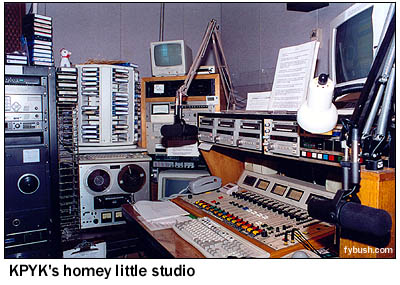 A quick inquiry
there tells us that the station is also in the strip mall, and
the four of us are soon inside the little mom-and-pop operation.
As Callarman puts it, "pop" isn't home, so a surprised
"mom" lets us take a few pictures before stepping back
into the studio to do a live top-hour ID! A quick inquiry
there tells us that the station is also in the strip mall, and
the four of us are soon inside the little mom-and-pop operation.
As Callarman puts it, "pop" isn't home, so a surprised
"mom" lets us take a few pictures before stepping back
into the studio to do a live top-hour ID!
KPYK's lone tower is just across the street next to the mall,
which makes for one of the shortest microwave STL hops we've
ever seen.
And with that, we're off to one of the most legendary
sites in all of American tower hunting.
In a land where six towers is a big site and eight towers
is a huge one, twelve towers is, well, Texas-sized - especially
when they're used only at night, as the site out in Rockwall,
Texas is.
Add to that the history of Gordon McLendon, one of the inventors
of top 40 radio, and his KLIF (1190), which built this site more
than thirty years ago, and you've got something that every tower
hunter should see once in a lifetime.
This site, designed to put a usable 1190 signal over Dallas
while protecting the dominant stations in Fort Wayne to the northeast,
Portland to the northwest and Guadalajara to the south, needs
all twelve of those towers to do it, cranking out an amazing
2642 millivolts of signal at 1 km in its massive broadside lobe
to the west while generating just 26 millivolts in the nulls
- all from a 5000-watt signal! How narrow is the main lobe? It
was once said that the KLIF night signal shot down the middle
of Commerce Street (a main Dallas artery) without ever touching
the curb on either side!
(The site went on the air in 1970, replacing KLIF's original
1000-watt night site on Scyene Road, not far from KSKY; while
it did improve the signal in Dallas and brought KLIF to Fort
Worth after dark, it missed the fast-growing suburbs north of
Dallas, where the 1190 signal is hard to hear at night even now.)
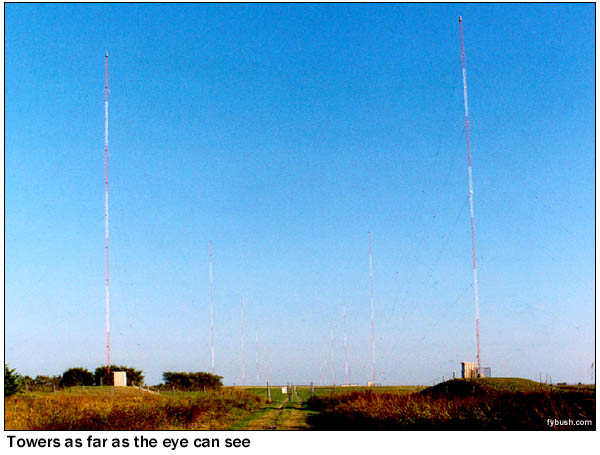
Without an airplane, it's almost impossible to get a picture
that does this site justice. These towers are widely spaced,
stretching out - and out - and out along the housing developments
that have just recently sprung up to the north. The only way
to get all 12 in frame is to pull down the access road from FM
549 (not a radio station, a "Farm-to-Market" highway!)
and up to the gate - and even then, the towers at the far end
all but vanish from view!
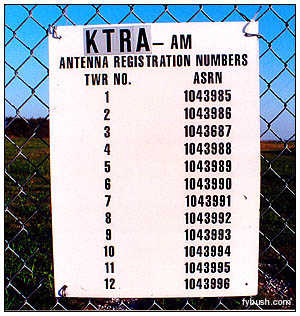 (The
story that a plane once mistook the long rows of red lights for
a runway and tried to land down the middle of the array is believed
to be apocryphal; it is true, however, that the poor engineer
on duty was required, back in the old days, to take readings
at the base of each of the 12 towers, which required a Jeep to
traverse the half-mile-long array!) (The
story that a plane once mistook the long rows of red lights for
a runway and tried to land down the middle of the array is believed
to be apocryphal; it is true, however, that the poor engineer
on duty was required, back in the old days, to take readings
at the base of each of the 12 towers, which required a Jeep to
traverse the half-mile-long array!)
As legendary as KLIF was, this site and the 1190 frequency
in general fell on some hard times after the McLendon era. Fairchild
Industries bought KLIF from McLendon in 1972, and the station
kept going with an AC format (McLendon, meanwhile, kept his FM
outlet, KNUS 98.7, today known as KLUV) but quickly succumbed
to the overall trend that was moving music listening to FM.
Susquehanna bought KLIF in 1980 and flipped the station to
country a year later, then to talk in 1986. And in 1990, Susquehanna
bought the former WFAA radio at 570 and moved the KLIF calls
and talk format to that superior signal.
1190 briefly became KLAF, a non-commercial simulcast of KLIF,
then switched to CNN news as KYII, then KUII under new owner
Greystone Broadcasting. Then came Salem, which took 1190 back
to talk as KGBS, and then to talk and religion as KDFX. And then
Salem traded 1190 to Infinity (for what's now KLTY 94.9),
which relaunched 1190 yet again as "Talk 1190," KOOO.
In 1998, 1190 regained a piece of its heritage when it was rejoined
with the old KLIF-FM/KNUS 98.7, by then doing oldies as KLUV.
1190 became oldies KLUV(AM), first with a simulcast of the FM
(whose morning man is veteran KLIF'er Ron Chapman) and then with
separate programming of 50s and early 60s oldies. And then
Infinity had to divest a station to stay within the market
caps, so 1190 was spun again to Radio One, which ran it for a
few months as oldies KJOI. Radio One then sold it to Clear Channel
in 2001, which flipped 1190 to Fox Sports as KTRA ("Xtra
Sports") and changed calls yet again to the current KFXR
("Fox Sports 1190") about a year ago.
Is it any wonder most people in Dallas (even those who actually
go back more than a few years in the Metroplex) have forgotten
about the Mighty 1190?
Next week, we'll see another huge Dallas signal and head out
to Fort Worth...see you then!
Special thanks to WFAA transmitter
engineer Don Guemmer, Wally Wawro, John Callarman, Chris Huff
of KSCS, Wayne Kube at Belo corporate, and KRLD's Tyler Cox!
Also be sure to check out Mike Shannon's excellent Dallas radio
history pages at www.knus99.com,
and Steve Eberhart's amazingly comprehensive History
of KLIF site...
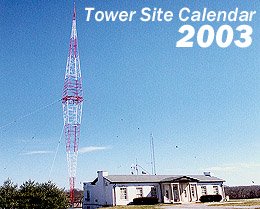 Like our recent WTIC picture? It's
one of the more than a dozen Tower Site images featured in the
2003 Tower Site Calendar, coming this fall from Tower Site of
the Week and fybush.com. Like our recent WTIC picture? It's
one of the more than a dozen Tower Site images featured in the
2003 Tower Site Calendar, coming this fall from Tower Site of
the Week and fybush.com.
If you liked last year's edition, you'll love this one: higher-quality
images (in addition to Avon Mountain, this year's edition includes
Providence's WHJJ; Mount Mansfield, Vermont; Buffalo's WBEN;
KOMA in Oklahoma City; the legendary WSM, Nashville; Brookmans
Park, England; WPAT, Paterson; Four Times Square, New York; WIBC
in Indianapolis; WWVA in Wheeling, W.V.; WGN Chicago and more),
more dates in radio history, a convenient hole for hanging -
and we'll even make sure all the dates fall on the right days!
This year's calendar will go to press very soon, and if you
order now, you'll have yours in hand by late November, in plenty
of time for the holidays. And this year, you can order with your
Visa, MasterCard, Discover or American Express by using the handy
link below!
Better yet, here's an incentive to make your 2003 NERW/Site
of the Week subscription pledge a little early: support NERW/fybush.com
at the $60 level or higher, and you'll get this lovely calendar
for free! How can you go wrong? (Click here
to visit our Support page, where you can make your NERW contribution
with a major credit card...)
You can also order by mail; just send a check for $16
per calendar (NYS residents add 8% sales tax), shipping included,
to Scott Fybush, 92 Bonnie Brae Ave., Rochester
NY 14618.
Thanks for your support!
|